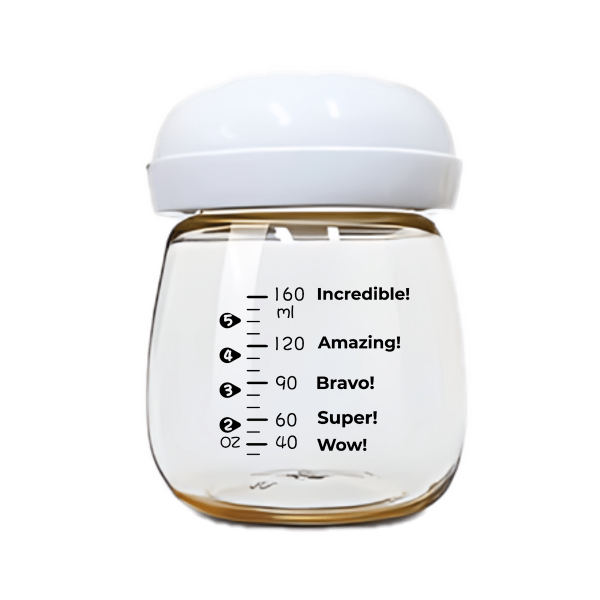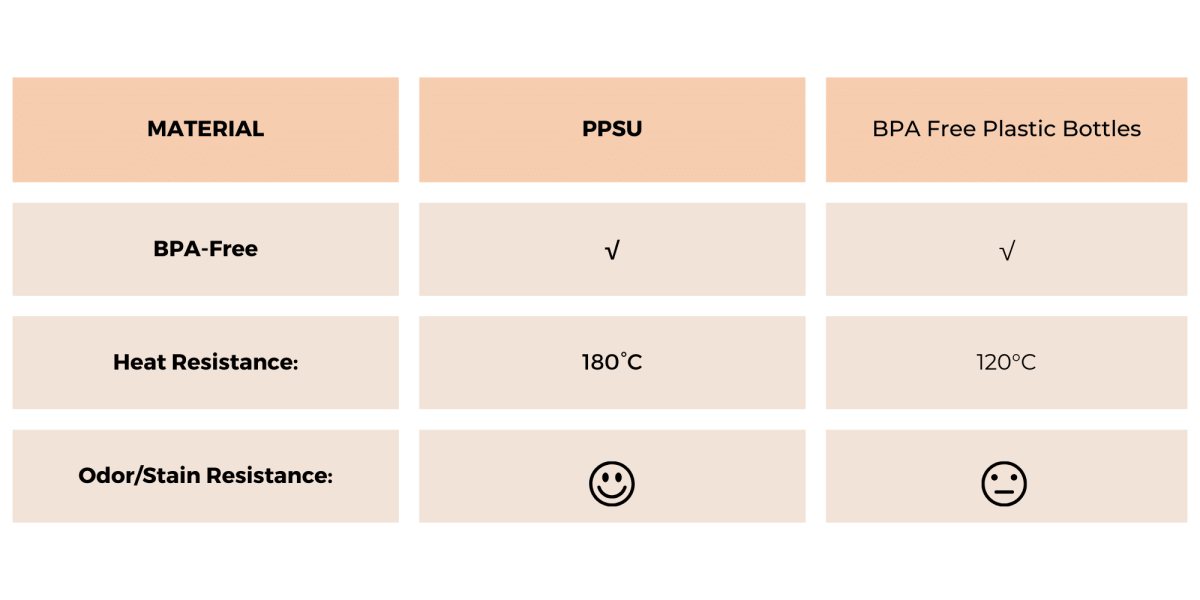What is PPSU?
Polyphenylsulfone (PPSU) is an advanced engineering thermoplastic that is widely chosen for medical and food contact applications due to its superior performance and safety profile. We’ve harnessed the exceptional qualities of PPSU to create storage bottles that ensure your peace of mind and your baby’s well-being.
Benefits of PPSU

BPA Free
PPSU is inherently free of BPA, a chemical commonly found in plastics that has been linked to health concerns. It is also non-toxic which means no harmful chemicals can leach into your baby’s milk, keeping feeding time safe and pure.

Heat Resistant
PPSU has a high thermal stability. It can withstand repeated sterilization and high temperatures without losing its shape or clarity.

Impact Resistant
With its high strength, PPSU bottles are less likely to crack or break, making them a dependable choice for everyday use. Unlike other plastics, PPSU doesn’t degrade with high heat, ensuring a longer lifespan even with regular sterilization.
Benefits of PPSU

BPA Free
PPSU is inherently free of BPA, a chemical commonly found in plastics that has been linked to health concerns. It is also non-toxic which means no harmful chemicals can leach into your baby’s milk, keeping feeding time safe and pure.

Heat Resistant
PPSU has a high thermal stability. It can withstand repeated sterilization and high temperatures without losing its shape or clarity.

Impact Resistant
With its high strength, PPSU bottles are less likely to crack or break, making them a dependable choice for everyday use. Unlike other plastics, PPSU doesn’t degrade with high heat, ensuring a longer lifespan even with regular sterilization.

Mommy Material's EverSafe PPSU Milk Storage Bottles
Celebrating Every Drop With You
We understand that breastfeeding is more than nutrition—it’s a nurturing act filled with joy, challenges, and profound bonding. That’s why our PPSU storage bottles are designed as more than just containers; they are your companions on this unique journey.
Each bottle features precise measurements and words of encouragement to remind you of your strength and the invaluable gift you provide. As you use our bottles, we hope you feel capable, competent, and cherished. We celebrate and support you, empowering you at every step of motherhood.

Mommy Material's EverSafe PPSU Milk Storage Bottles
Celebrating Every Drop With You
We understand that breastfeeding is more than nutrition—it’s a nurturing act filled with joy, challenges, and profound bonding. That’s why our PPSU storage bottles are designed as more than just containers; they are your companions on this unique journey.
Each bottle features precise measurements and words of encouragement to remind you of your strength and the invaluable gift you provide. As you use our bottles, we hope you feel capable, competent, and cherished. We celebrate and support you, empowering you at every step of motherhood.
The PPSU Difference
PPSU vs. BPA-Free Plastic

FAQ
Questions Asked
How do I wash and sterilize PPSU bottles?
Washing Instructions:
- Pre-Wash: Rinse each bottle and its components with cool water to remove any remaining milk residue.
- Hand Washing:
- Use warm, soapy water and a bottle brush to thoroughly clean each part of the bottle, especially the neck and the inside base where milk residue can accumulate.
- Pay special attention to the nipple/teat, ensuring all milk and food residues are removed.
- Rinse thoroughly under running water to ensure all soap has been removed.
- Dishwasher Safe:
- PPSU bottles are dishwasher safe. Place bottles and components on the top rack of the dishwasher to avoid direct exposure to heating elements.
- Use mild dishwasher detergent and a gentle water cycle.
- Ensure that all pieces are placed facing down to allow water to drain effectively.
Sterilizing Instructions:
- Boiling:
- Fill a large pot with enough water to completely submerge the bottles and their components.
- Bring water to a boil, then carefully place the disassembled bottles into the pot.
- Boil for 5-7 minutes to sterilize.
- Use tongs to remove the items and place them on a clean, dry towel or drying rack.
- Steam Sterilizer:
- Use a commercially available electric steam sterilizer according to the manufacturer’s instructions.
- Ensure that bottles and components are disassembled before placing them in the sterilizer.
- Microwave Sterilization:
- Special microwave sterilizing bags or containers designed for baby bottles can be used.
- Follow the manufacturer’s instructions for adding water and setting the time.
After Sterilizing:
- Drying: Let bottles and parts air dry on a clean drying rack or towel. Do not use cloths to dry, as they can spread germs.
- Storage: Keep dried bottles and components in a clean, sealed storage area to prevent dust and contamination.
How can I safely store PPSU bottles?
- Cool Milk Before Storing: Allow freshly pumped milk to cool before sealing the bottle to prevent condensation and potential bacterial growth.
- Leave Space at the Top: Always leave about an inch of space at the top of the bottle before sealing, to allow for milk expansion, especially if freezing.
What is the right way to store breast milk?
- Room Temperature: Expressed breast milk can be stored at room temperature for up to 4 hours. If the room is particularly warm (over 25°C), it is best to use the milk within two hours.
-
Refrigerator: Expressed breast milk can be stored in the refrigerator for up to 4 days at a temperature of 4°C (39°F) or lower.
-
Freezer: Expressed breast milk can be stored in the freezer for up to 6 months. Thaw the milk in the refrigerator, under running warm water, or in a bowl of warm water.
How can I warm breast milk?
- Thaw frozen milk in the refrigerator overnight or by holding the bottle under warm running water.
- Warm the milk by placing the bottle in a bowl of warm water or electrical bottle warmer. Remember to test the milk temperature.
IMPORTANT: Do not use a microwave to heat the milk in the bottles. Microwaving can create hot spots within the milk, leading to uneven heating and a risk of burning your baby’s mouth. Furthermore, microwaving can degrade the quality of breast milk by destroying beneficial nutrients and antibodies.
Once thawed, do not refreeze breast milk.
Use within 24 hours of thawing.
FAQ
Questions Asked
How do I wash and sterilize PPSU bottles?
Washing Instructions:
- Pre-Wash: Rinse each bottle and its components with cool water to remove any remaining milk residue.
- Hand Washing:
- Use warm, soapy water and a bottle brush to thoroughly clean each part of the bottle, especially the neck and the inside base where milk residue can accumulate.
- Pay special attention to the nipple/teat, ensuring all milk and food residues are removed.
- Rinse thoroughly under running water to ensure all soap has been removed.
- Dishwasher Safe:
- PPSU bottles are dishwasher safe. Place bottles and components on the top rack of the dishwasher to avoid direct exposure to heating elements.
- Use mild dishwasher detergent and a gentle water cycle.
- Ensure that all pieces are placed facing down to allow water to drain effectively.
Sterilizing Instructions:
- Boiling:
- Fill a large pot with enough water to completely submerge the bottles and their components.
- Bring water to a boil, then carefully place the disassembled bottles into the pot.
- Boil for 5-7 minutes to sterilize.
- Use tongs to remove the items and place them on a clean, dry towel or drying rack.
- Steam Sterilizer:
- Use a commercially available electric steam sterilizer according to the manufacturer’s instructions.
- Ensure that bottles and components are disassembled before placing them in the sterilizer.
- Microwave Sterilization:
- Special microwave sterilizing bags or containers designed for baby bottles can be used.
- Follow the manufacturer’s instructions for adding water and setting the time.
After Sterilizing:
- Drying: Let bottles and parts air dry on a clean drying rack or towel. Do not use cloths to dry, as they can spread germs.
- Storage: Keep dried bottles and components in a clean, sealed storage area to prevent dust and contamination.
How can I safely store PPSU bottles?
- Cool Milk Before Storing: Allow freshly pumped milk to cool before sealing the bottle to prevent condensation and potential bacterial growth.
- Leave Space at the Top: Always leave about an inch of space at the top of the bottle before sealing, to allow for milk expansion, especially if freezing.
What is the right way to store breast milk?
- Room Temperature: Expressed breast milk can be stored at room temperature for up to 4 hours. If the room is particularly warm (over 25°C), it is best to use the milk within two hours.
-
Refrigerator: Expressed breast milk can be stored in the refrigerator for up to 4 days at a temperature of 4°C (39°F) or lower.
-
Freezer: Expressed breast milk can be stored in the freezer for up to 6 months. Thaw the milk in the refrigerator, under running warm water, or in a bowl of warm water.
How can I warm breast milk?
- Thaw frozen milk in the refrigerator overnight or by holding the bottle under warm running water.
- Warm the milk by placing the bottle in a bowl of warm water or electrical bottle warmer. Remember to test the milk temperature.
IMPORTANT: Do not use a microwave to heat the milk in the bottles. Microwaving can create hot spots within the milk, leading to uneven heating and a risk of burning your baby’s mouth. Furthermore, microwaving can degrade the quality of breast milk by destroying beneficial nutrients and antibodies.
Once thawed, do not refreeze breast milk.
Use within 24 hours of thawing.
